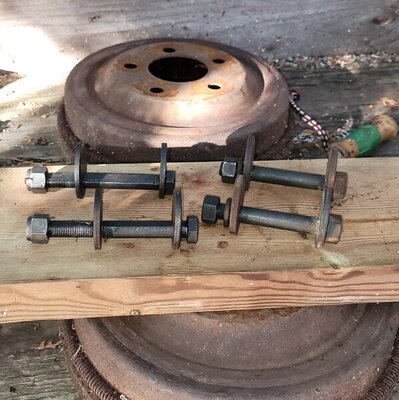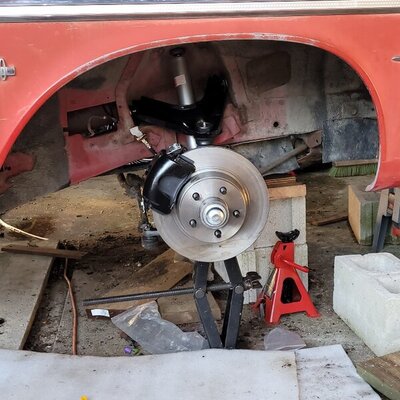You are using an out of date browser. It may not display this or other websites correctly.
You should upgrade or use an alternative browser.
You should upgrade or use an alternative browser.
Help: need UCA torque specs
- Thread starter Dan mckillip
- Start date
- Local time
- 12:20 PM
- Joined
- Dec 4, 2009
- Messages
- 34,082
- Reaction score
- 41,889
- Location
- Pasadena, Texas
For 5/8ths fine thread.....180 but the book I have used for years has 238 on the nut! Might look research it on the net for some agreement. Dry vs lubed is always different too. BTW, don't torque them until you get the car sitting at ride height!!
https://www.dultmeier.com/pdfs/tech-library/C_BoltTorque.pdf
https://www.dultmeier.com/pdfs/tech-library/C_BoltTorque.pdf
66 Sat
Well-Known Member
Surely that's for the ball joint to the UCA? I thought the cam bolts were about 70-80 lbs/ft?For 5/8ths fine thread.....180 but the book I have used for years has 238 on the nut! Might look research it on the net for some agreement. Dry vs lubed is always different too. BTW, don't torque them until you get the car sitting at ride height!!
https://www.dultmeier.com/pdfs/tech-library/C_BoltTorque.pdf
Darter6
Well-Known Member
I just looked at the 1964 factory service manual.There is no torque spec listed.There is a misprint stating the lower control arm twice with a torque of 180 ft lbs and 130 ft lbs. ?? It has been proven that the manuals do have wrong info printed most often the torque specs.
The 1966 FSM shows a torque of 65 ft lbs. At 65 ft lbs I have found that is not enough.Hit the brakes hard and that torque will not hold the cams from turning.
If you must torque I would go a minimum of 100 ft lbs. I did alignments for years and would make them as tight as possible.Didn't want comebacks.
Just my thought,others may differ.
The 1966 FSM shows a torque of 65 ft lbs. At 65 ft lbs I have found that is not enough.Hit the brakes hard and that torque will not hold the cams from turning.
If you must torque I would go a minimum of 100 ft lbs. I did alignments for years and would make them as tight as possible.Didn't want comebacks.
Just my thought,others may differ.
747mopar
Well-Known Member
That's what I do but I also understand not everyone has wrenched most of their life to know what's tight enough.Has any one actually put a torque wrench in there? I think tightening them as good and tight as you can with a 1/2” ratchet with one good arm on it should do.
66 Sat
Well-Known Member
The funny thing is, you can only get a torque wrench in there when the car is off the wheels, or has the front wheel removed, but then you can't tighten them because you need the car on it's tires with the full weight - it's a real catch-22.
The hard part is as you get older and your strength decreases or you get a bit of arthritis, you might not be tightening it as much as you once were.
The hard part is as you get older and your strength decreases or you get a bit of arthritis, you might not be tightening it as much as you once were.
Cam bolt nuts = 65 foot-pounds per FSMI'm installing upper control arms on 64 polara, I can't seem to find torque specs on bolts attaching to body. Anyone help with this?
Thanks!
View attachment 1157790
Dan mckillip
Active Member
That's what I do but I also understand not everyone has wrenched most of their life to know what's tight enough.
Thanks for all the input, I really appreciate all.
I originally, before I posted this question, set torque
Wrench to 100 ft lb. And stripped the bolt threads. (wheel not loaded) Couldn't find a torque spec, so pulled stripped bolts out and installed the original bolts to 35 ft lb to be safe. The bolt is a 1/2", but its flat on one side. Ill up load a picture of stripped bolts and original bolts.
So I installed the original bolts to 35 ft lbs, ill run the final torque on the nuts when the wheel is loaded at ride height. ?
Sound reasonable?
Thanks for feedback.
Dan
Cam bolt nuts = 65 foot-pounds per FSM


Yeah for some reason, in my manual anyway, the spec for the cam bolts isn't in the "Tightening Reference" section. They give it at the very end of the Upper Control Arm Installation section, after instructing to "measure and adjust vehicle height and wheel alignment".Thanks for all the input, I really appreciate all.
I originally, before I posted this question, set torque
Wrench to 100 ft lb. And stripped the bolt threads. (wheel not loaded) Couldn't find a torque spec, so pulled stripped bolts out and installed the original bolts to 35 ft lb to be safe. The bolt is a 1/2", but its flat on one side. Ill up load a picture of stripped bolts and original bolts.
So I installed the original bolts to 35 ft lbs, ill run the final torque on the nuts when the wheel is loaded at ride height. ?
Sound reasonable?
Thanks for feedback.
Dan
View attachment 1157843 View attachment 1157852
747mopar
Well-Known Member
I'm a fairly strong guy, I just torque them with a regular wrench but your alignment guy will likely be the last guy to wrench on them. Yes, torqued sitting on it's full weight but loosen them back up and let the bushing relax before final torque. Reason for this is the rubber bushings are bonded to the steel sleeve and do not rotate but instead it twists the rubber. Torquing the bolts with the suspension dangling locks the bushings in at the lowest point meaning the rubber is already loaded at ride height, hit some big bumps and your really stretching the limits. In short, they'll last much longer if done correctly.. or add poly bushings which do rotate.
Dan mckillip
Active Member
ThanksI'm a fairly strong guy, I just torque them with a regular wrench but your alignment guy will likely be the last guy to wrench on them. Yes, torqued sitting on it's full weight but loosen them back up and let the bushing relax before final torque. Reason for this is the rubber bushings are bonded to the steel sleeve and do not rotate but instead it twists the rubber. Torquing the bolts with the suspension dangling locks the bushings in at the lowest point meaning the rubber is already loaded at ride height, hit some big bumps and your really stretching the limits. In short, they'll last much longer if done correctly.. or add poly bushings which do rotate.

















